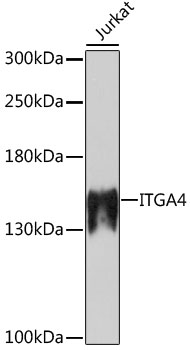-
Product Name
ITGA4 Polyclonal Antibody
- Documents
-
Description
Polyclonal antibody to ITGA4
-
Tested applications
WB, IHC
-
Species reactivity
Human, Mouse, Rat
-
Alternative names
ITGA4 antibody; CD49D antibody; IA4 antibody; integrin alpha-4 antibody
-
Isotype
Rabbit IgG
-
Preparation
Antigen: A synthetic peptide corresponding to a sequence within amino acids 900 to the C-terminus of human ITGA4 (NP_000876.3).
-
Clonality
Polyclonal
-
Formulation
PBS with 0.02% sodium azide, 50% glycerol, pH7.3.
-
Storage instructions
Store at -20℃. Avoid freeze / thaw cycles.
-
Applications
WB 1:500 - 1:2000
IHC 1:50 - 1:100 -
Validations

Western blot - ITGA4 Polyclonal Antibody
Western blot analysis of extracts of Jurkat cells, using ITGA4 antibody at 1:1000 dilution.Secondary antibody: HRP Goat Anti-Rabbit IgG (H+L) at 1:10000 dilution.Lysates/proteins: 25ug per lane.Blocking buffer: 3% nonfat dry milk in TBST.Detection: ECL Basic Kit .Exposure time: 90s.
-
Background
Integrins alpha-4/beta-1 (VLA-4) and alpha-4/beta-7 are receptors for fibronectin. They recognize one or more domains within the alternatively spliced CS-1 and CS-5 regions of fibronectin. They are also receptors for VCAM1. Integrin alpha-4/beta-1 recognizes the sequence Q-I-D-S in VCAM1. Integrin alpha-4/beta-7 is also a receptor for MADCAM1. It recognizes the sequence L-D-T in MADCAM1. On activated endothelial cells integrin VLA-4 triggers homotypic aggregation for most VLA-4-positive leukocyte cell lines. It may also participate in cytolytic T-cell interactions with target cells. ITGA4:ITGB1 binds to fractalkine (CX3CL1) and may act as its coreceptor in CX3CR1-dependent fractalkine signaling. ITGA4:ITGB1 binds to PLA2G2A via a site (site 2) which is distinct from the classical ligand-binding site (site 1) and this induces integrin conformational changes and enhanced ligand binding to site 1.
Related Products / Services
Please note: All products are "FOR RESEARCH USE ONLY AND ARE NOT INTENDED FOR DIAGNOSTIC OR THERAPEUTIC USE"
